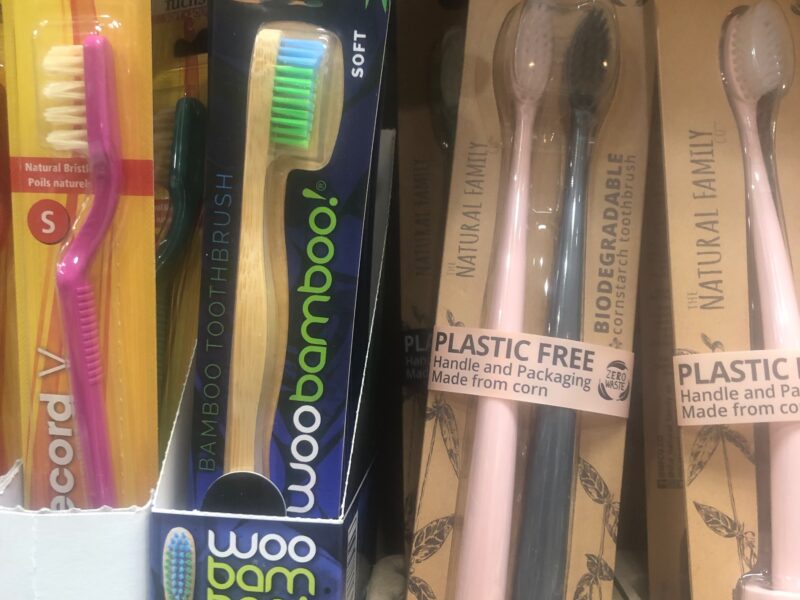

Buying a bamboo toothbrush is one of the many environmental choices that my daughter, Carley, likes to call a “performative act,” as in the tiny and superficial gesture one makes that’s meaningless in the face of global warming, and that’s done only to make oneself feel better.
She thinks everything is a performative act. Eating oysters. Riding a bike. Passing 370 billion dollars of climate legislation. The other day she said, “You and your little column. That’s just a performative act.”
So let’s take a look at our Lilliputian friend, the bamboo toothbrush. Weighing in at a diminutive 11 grams and 7.5 inches in length, it wouldn’t seem a likely candidate for saving the world.
If we follow dentists recommendations of using a new toothbrush every three months (big ‘If’), we go through a lot of toothbrushes. When I multiply my age of 58 times four plastic toothbrushes a year, I’m at 232 and counting. It’s plastic that’s not exactly “single use,” but not sustainable over the long haul either.
The conventional toothbrush is made from a variety of hard plastics, all of which are sourced from fossil fuels, and take more than 500 years to fully break down.
An estimated one billion plastic toothbrushes go into the landfill every year in the United States. And those that don’t end up in a landfill, join the 5.25 trillion pieces of plastic debris swimming the oceans. Some might even end up in the Texas-sized vortex of trash known as The Great Pacific Garbage Patch.
A toothbrush made from bamboo, on the other hand, is almost entirely biodegradable. Just pull the nylon bristles off with pliers and throw it in the compost, where it will break down in about six months. Even with noncompostable nylon bristles, a bamboo toothbrush eliminates 90 percent of the plastic used in traditional toothbrush production.
If a toothbrush has a replaceable handle, it’s even more sustainable because you only change its head every three months, rather than the full body. If you can’t find a toothbrush with a replaceable head made from bamboo, there are a variety of good options made out of recycled material.
What makes a toothbrush, or any bamboo product, so much more than performative, isn’t just that it’s helping avoid plastic, but that bamboo itself is a powerhouse at drawing down carbon from the atmosphere. Bamboo sequesters carbon faster than almost any other plant and keeps it in the soil for thousands of years. Some bamboo species are capable of sequestering up to 300 tons of carbon per acre over a lifetime. (That’s about 165 round trip flights to Paris and back.)
Below ground, bamboo’s root system also captures tons of carbon. “While the average life span of an individual bamboo culm is less than ten years, the roots can live for decades storing carbon,” according to the book “Regeneration.”
Bamboo is the weed we love to hate. And with good reason. While the garden variety of “clumping” bamboo doesn’t spread (and doesn’t do much for the environment either), the tree-like bamboo species spreads its appropriately named “runners” anywhere it pleases and with menacing speed. (Luckily, it’s been banned from sale in New York for years).
What makes this tree so horrific in your yard is exactly why it’s the most renewable building material on the planet. Most trees, even when sustainably sourced, are slow to regrow. Pine trees take up to 30 years to harvest and oak up to 80 years. Holding the Guinness Book of World Records for fastest growing plant is bamboo, which reaches maturity in just five years. Some species can grow 30 inches in a single day.
“You can sit by timber bamboo in the spring and watch it grow more than one inch an hour,” according to Paul Hawkins’ best-selling book “Drawdown.”
As a crop, bamboo requires less land to grow, doesn’t need fertilizers, pesticides or irrigation, and reportedly may provide a third more oxygen to the atmosphere than a similar-sized stand of trees.
Bamboo can also grow in the most inhospitable terrain in thin soil and on steep and eroded slopes. For years, China has been growing bamboo on degraded lands where other crops won’t grow.
Before I discovered the bamboo toothbrush, I’d always thought that bamboo was just panda bear food and the trappings of some kitschy 1950s tiki bar. The fact is that bamboo can be used for almost anything — from furniture, biofuels and animal feed, to toilet paper and even the plumbing the TP is flushed through. When used as paper, bamboo produces six times as much pulp as that from a conventional pine plantation. Because bamboo has greater tensile strength than steel, and greater compressive strength than concrete, yet is lightweight, it can be used for boats, bridges, bikes and skateboards. It’s used in almost every aspect of building, from frame to floor to shingles, replacing wood that’s often culled from endangered forest systems. The French, always ready to go the extra mile for fashionable sportswear, even make a bike helmet from bamboo.
Every time we produce something with bamboo, it’s replacing the plastic, steel, aluminum and concrete that emit massive amounts of greenhouse gases in production.
“If it can’t be done with bamboo, it probably shouldn’t be done,” says Fred Hornaday, philosopher and bamboo expert.
As with most environmental solutions, bamboo has its drawbacks. Like any monoculture, bamboo plantations can’t rebuild the diversity of a real forest.
And when wild, its invasive spreading crowds out native plant species. The majority of bamboo is grown in China (as of right now), so shipping it here still creates CO2 emissions. But considering the bonanza of environmental benefits bamboo offers, the benefits still far outweigh the drawbacks.
I have to concede that there may be a bit of truth in Carley’s criticism. The bamboo toothbrush-size changes we make are performative if they’re all we do. We have to make the big changes that genuinely reduce CO2 emissions — changing the way we get around, how we eat and the energy we use to power our houses.
At the same time, as Voltaire liked to say, “Don’t let perfect be the enemy of the good.”
 More Posts from Jenny Noble
More Posts from Jenny Noble